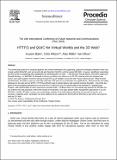HTTP/2 and QUIC for virtual worlds and the 3D Web?
Abstract
The continuing advances in computer graphics and Internet bandwidths are supporting a gradual convergence between multi-user virtual worlds (MUVW), such as Second Life and OpenSim (SL/OS), and the nascent 3D Web. However, significant networking barriers remain to exploiting these capabilities for developing the 3D Web. These barriers include latency of content update and firewall blocking. In MUVWs the firewall and latency problems are related as the SL/OS network protocols designed over twelve years ago sought to minimise latency through the use of multiple concurrent UDP-based virtual circuits. Most firewall administrators are loathe to open up over fifty unknown UDP ports to accommodate such applications. New protocols now being deployed on the web such as SPDY, HTTP/2 and QUIC seek to reduce latency and routinely traverse firewalls. One of the key goals of the convergence between MUVWs and the 3D Web is for MUVW functionality to be provided in a standard web browser, with optional links to other autonomous virtual worlds. It follows that as an incremental step towards the 3D Web the use of these new web protocols in MUVWs should be researched. This paper details traffic management approaches in SL/OS MUVWs, clarifies 3D Web concepts and terminology, explains the functionality provided by the new web protocols, and provides a mapping which postulates how their features can be exploited for the benefit of MUVWs as part of the convergence with the 3D Web
Citation
Bakri , H , Allison , C , Miller , A H D & Oliver , I A 2015 , HTTP/2 and QUIC for virtual worlds and the 3D Web? in Procedia Computer Science : The 10th International Conference on Future Networks and Communications (FNC 2015) / The 12th International Conference on Mobile Systems and Pervasive Computing (MobiSPC 2015) Affiliated Workshops . vol. 56 , Elsevier , pp. 242-251 , The 10th International Conference on Future Networks and Communications (FNC 2015) , Belfort , France , 17/08/15 . conference
Publication
Procedia Computer Science
Type
Conference item
Collections
Items in the St Andrews Research Repository are protected by copyright, with all rights reserved, unless otherwise indicated.

